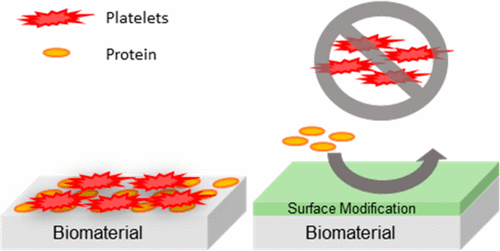当前位置:
X-MOL 学术
›
ACS Macro Lett.
›
论文详情
Our official English website, www.x-mol.net, welcomes your feedback! (Note: you will need to create a separate account there.)
Protein Resistant Polymeric Biomaterials
ACS Macro Letters ( IF 5.8 ) Pub Date : 2017-08-29 00:00:00 , DOI: 10.1021/acsmacrolett.7b00448 Bryan Khai D Ngo 1 , Melissa A Grunlan 2
ACS Macro Letters ( IF 5.8 ) Pub Date : 2017-08-29 00:00:00 , DOI: 10.1021/acsmacrolett.7b00448 Bryan Khai D Ngo 1 , Melissa A Grunlan 2
Affiliation

|
Toward improving implantable medical devices as well as diagnostic performance, the development of polymeric biomaterials having resistance to proteins remains a priority. Herein, we highlight key strategies reported in the recent literature that have relied upon improvement of surface hydrophilicity via direct surface modification methods or with bulk modification using surface modifying additives (SMAs). These approaches have utilized a variety of techniques to incorporate the surface hydrophilization agent, including physisorption, hydrogel network formation, surface grafting, layer-by-layer (LbL) assembly and blending base polymers with SMAs. While poly(ethylene glycol) (PEG) remains the gold standard, new alternatives have emerged such as polyglycidols, poly(2-oxazoline)s (POx), polyzwitterions, and amphiphilic block copolymers. While these new strategies provide encouraging results, the need for improved correlation between in vitro and in vivo protein resistance is critical. This may be achieved by employing complex protein solutions as well as strides to enhance the sensitivity of protein adsorption measurements.
中文翻译:

蛋白质抗性高分子生物材料
为了改进可植入医疗设备以及诊断性能,开发具有蛋白质抗性的聚合物生物材料仍然是当务之急。在这里,我们强调了最近文献中报道的关键策略,这些策略依赖于通过直接表面改性方法或使用表面改性添加剂 (SMA) 进行本体改性来提高表面亲水性。这些方法利用多种技术来结合表面亲水剂,包括物理吸附、水凝胶网络形成、表面接枝、逐层 (LbL) 组装以及将基础聚合物与 SMA 混合。虽然聚 (乙二醇) (PEG) 仍然是黄金标准,但已经出现了新的替代品,例如聚缩水甘油、聚 (2-恶唑啉) (POx)、多两性离子和两亲嵌段共聚物。虽然这些新策略提供了令人鼓舞的结果,但需要改善体外和体内蛋白质抗性之间的相关性是至关重要的。这可以通过使用复杂的蛋白质溶液以及跨步来提高蛋白质吸附测量的灵敏度来实现。
更新日期:2017-08-29
中文翻译:

蛋白质抗性高分子生物材料
为了改进可植入医疗设备以及诊断性能,开发具有蛋白质抗性的聚合物生物材料仍然是当务之急。在这里,我们强调了最近文献中报道的关键策略,这些策略依赖于通过直接表面改性方法或使用表面改性添加剂 (SMA) 进行本体改性来提高表面亲水性。这些方法利用多种技术来结合表面亲水剂,包括物理吸附、水凝胶网络形成、表面接枝、逐层 (LbL) 组装以及将基础聚合物与 SMA 混合。虽然聚 (乙二醇) (PEG) 仍然是黄金标准,但已经出现了新的替代品,例如聚缩水甘油、聚 (2-恶唑啉) (POx)、多两性离子和两亲嵌段共聚物。虽然这些新策略提供了令人鼓舞的结果,但需要改善体外和体内蛋白质抗性之间的相关性是至关重要的。这可以通过使用复杂的蛋白质溶液以及跨步来提高蛋白质吸附测量的灵敏度来实现。


























 京公网安备 11010802027423号
京公网安备 11010802027423号